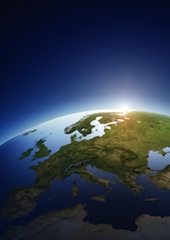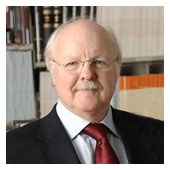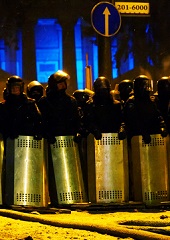Twentieth Century Milestones in 2014
Can we use the milestones and guideposts of the past century to deal with current choices?
February 9, 2014

During 2014, there will be many different historical milestones, marked with differing purposes yet often with overlapping messages. Three in particular will stand out for Germany, but will be marked by more people than only the Germans.
The opening gunfire of World War I in August of 1914 will be once again remembered. After a century of analysis and arguments, the answers to the two main questions — how and why — remain contentious. The pivotal role of the so-called “war to end all wars” in understanding the path of the last century remains a fixture of debate.
At the center of that debate is an effort to extract lessons from this catastrophe, which killed millions and helped set the stage for further millions to perish a generation later.
Perhaps the anniversary becomes more relevant when one looks at the factors at play and compares them with today’s world.
As Christopher Clark points out in “The Sleepwalkers,” today we are less distanced from the events of a century ago. He writes, “The attack on the World Trade Center in September 2001 exemplified the ways in which a single, symbolic event — however deeply it may be enmeshed in larger historical processes — can change politics, irrevocably rendering old options obsolete and endowing new ones with an unforeseen urgency.”
Such was the case in 1914. Such was the case on 9/11.
Versailles to Munich
Despite the heady proclamations of leaders in Versailles, the efforts to bind the wounds of the Great War were quickly meshed into the roots of the next war, giving fertile ground for the seeds of fascism to grow.
The national interwar narratives competing for support exploded into self-serving rationales full of mistrust and hate of “the other” both within and across borders. That was the same formula that had launched the war in 1914. There were lessons to be learned, but those that reinforced the momentum toward war again gained traction.
In turning to the seventy-fifth anniversary of the formal beginning of World War II in September of 1939, we see a continuing process that emerges from the catastrophic slaughter of WWI and the infections it caused over the most of the first half of the twentieth century.
While the disease of fascism morphed in Germany into the cancer of Nazism, it spread itself throughout Europe and was already rampant in Japan, which terrorized Asia for decades.
Again we can ask how and why — within an historical blink of an eye — the world was caught in the maelstrom of murderous world wars twice in a half century.
Indeed, the second one brought forth more evil and poison than ever conceived among people against other people. And we still try to draw from the consequences to end these circles of death.
With great fanfare, it was declared in 1945 that swords would be beaten into plowshares — again. Institutions were created to help prevent and mediate conflicts, spurred on by the graphic picture of a mushroom cloud and millions dead. There was a moment to hope that the cycle could be broken.
But again, the promise remains just that. The pronouncements around the birth of the United Nations in the spring of 1945 were lofty.
But those intentions were left standing as the military results of 1945 turned into hard politics again and laid the basis for a continuation of battle lines, eventually embodied in a wall running through Berlin and conflict throughout the world during the following decades.
The Berlin Wall’s fall reconfigures Europe
The third milestone being marked in 2014 is the twenty-fifth anniversary of the beginning of the end of the Berlin Wall. This began the gradual healing of some scars still very visible throughout Europe and elsewhere around the globe.
While Germany united, other countries split apart, as Czechoslovakia did, and still others disappeared entirely, such as the Soviet Union and Yugoslavia.
Meanwhile, new forms of bloody conflict often appeared precisely in the same areas that spawned the outbreak of war in 1914.
And despite the end of the Cold War, the legacies of division, colonialism and artificial boundaries elsewhere in the world reemerged in the Middle East, Asia and Africa and brought far more death than liberation.
With such major historical reminders of both the limits and the possibilities of peoples and nations to remake and reshape the world, 2014 is also a time to reflect on our achievements, despite the challenges.
The United States stood uniquely on the world stage in 1945 as a champion of renewal and resource-driven effort. The path it took was not flawless, but there was a commitment to rebuild a devastated world where it could.
That the United States was motivated in that commitment by the confrontation with the Soviet Union is undeniable. Yet without it, certainly Europe would not be what it is today.
In fact, Europe today remains testimony to an idea — and indeed a reality — that the sum of many nations can be greater than its parts, that the premise and promise of a world united as described in San Francisco in 1945 can be pursued and achieved even if it is in part incomplete.
There is no other or better showcase than the forging of European unity, an effort that arose out of the ashes of millions, whose legacy is our responsibility today.
Recognizing its history, Germany has assumed responsibility and indeed leadership, in forging bridges of remembrance and renewal with its neighbors, especially with Israel. Germany has a message for others still challenged with building those bridges elsewhere in the world. It can be done. Those walls from the past can be overcome.
As in other years gone by, 2014 offers many milestones to use as guideposts for dealing with the current choices we face. These guideposts warn of missed opportunities and teach us to recognize new ones and use them. At the end of this year, we will know whether we have learned more.
A version of this piece originally appeared at AICGS.org.
Takeaways
2014 offers many milestones to use as guideposts for dealing with the current choices we face.
The anniversary of WWI becomes more relevant when one compares the factors at play with today’s world.
The heady proclamations from Versailles were quickly meshed into the roots of the next war.
Why was the world caught in the maelstrom of murderous world wars twice in a half century?
The lofty intentions of 1945 were left standing as military results turned into hard politics again.
2014 marks the 25th anniversary of the end of the Berlin Wall, which began the healing of some scars in Europe.
The United States stood uniquely in 1945 as a champion of renewal and resource-driven effort.
Europe remains testimony to an idea and a reality that the sum of many nations can be greater than its parts.
At the end of this year, we will know whether we have learned more.

